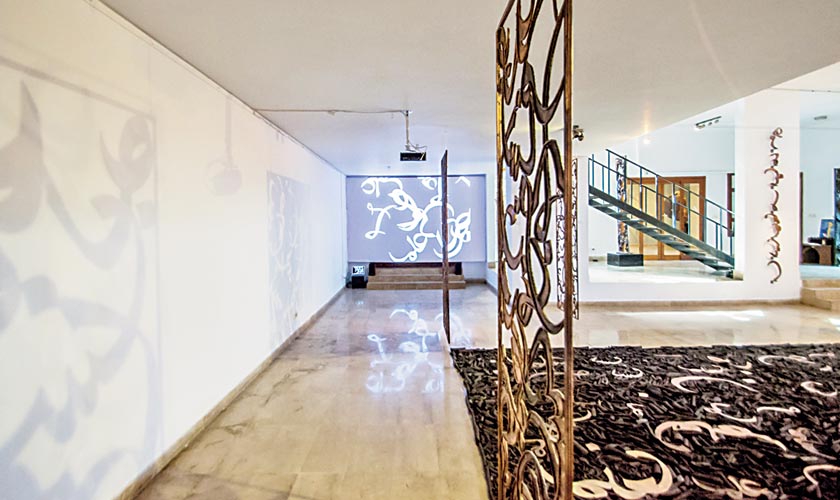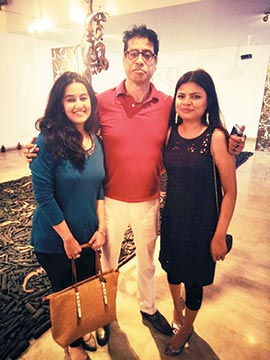The power of 7
This week, You! talks to renowned artist, Amin Gulgee, regarding his latest art installation in Karachi…
exhibition
This week, You! talks to renowned artist, Amin Gulgee, regarding his latest art installation in Karachi…
A few artists have their names associated with ingenuity and originality in Pakistan and the world over. Only some of them have understood that art can’t be imitated and it is something which completely relies on an artist’s pure imaginations and ideology. One such name in the world of art is of Amin Gulgee. Armed with a Bachelor of Art in Economics and Art History from the prestigious Yale University, USA, Amin Gulgee began his career as an artist in 1990 from his native city of Karachi. Using this ancient land and its rich, diverse history as his muse, his creations synergise Hindu mythology, Buddhist asceticism and Islamic calligraphy to explore the underlying spirituality of man.
Amin Gulgee’s latest installation in Karachi, titled ‘7’, was recently on display at Amin Gulgee Gallery, Clifton, Karachi, and will shortly depart the city heading to the Eternal City, Rome, for the Galleria d’Arte Moderna [GAM], where the work will be curated by Paolo de Grandis and Claudio Crescentini.
Scrolls of large metal structures; this larger than life installation consists of the fifth verse of al-Alaq in the Quran divided into seven pieces. Gulgee often scripts this verse from the 96th chapter of the Holy Quran on his artwork. Surah al-Alaq (‘The Clot’, also referred to as ‘al-Iqra’) is believed to be the first revelation sent to the Prophet Muhammad in the cave Hira, in the city of Mecca. The fifth verse is where we are told that God “Taught man that which he did not know.”
Having constructed and deconstructed it so many times in the past decade, it has now become internalised and Gulgee embodies it through ‘7’, where the sentence is itself divided into seven portions and these seven sections are repeated several times, and hence the name of the exhibit.
While talking to this scribe, Gulgee talked about his recent activities from curating last year’s ‘Karachi Biennele’ and now to be showcasing his work in Rome, representing Pakistan at this prestigious global art solo show.
“It’s wonderful to be in my workshop, back in my day job. Also, I am absolutely thrilled to be going to Rome. It is a city that has always a special place in my heart. I studied art history and my fascination was with the Roman Renaissance,” shared Amin Gulgee.
“The whole point of this show is that the text is not readable, although the content comes from a special source for me, I am going beyond content,” described Gulgee, for whom, all pieces of art in the show are one installation.
The artist has internalised the words, and he allows the pieces to do the same, free-flowing, delving into the heart of the verse itself; as according to an official essay by Zarmeene Shah that accompanies the immersive experience of the exhibition, “The power and possibility within that which is not known.”
“For ‘7’, I have divided the verse into seven sections and the words are repeated throughout the exhibition,” told Gulgee. “You cannot read the text, so the pieces are like my private messages and private love letters.”
This romantic sentiment is carried through to the entrance, where glass bottles are displayed with notepaper and an invitation to write a private message and place it in a bottle, which you bring inside and becomes a part of the exhibition. At the end of the exhibition, Gulgee would burn the bottles and destroy the messages so they will remain private.
“This is a performance element to the exhibition,” explains the artist. “These bottles full of private love messages were my way of engaging everyone in the installation as their words and thoughts literally become part of the organic ‘7’.”
This deliberate inclusion is one of the many charms to this well-thought out show.
“There is also an algorithm that’s projected onto a screen in the installation where these seven parts to the phrase appear randomly till the screen goes white, then they become black, then white, and each time a letter appears, one tone of the rubab is heard,” explained Gulgee.
When asked why the verse was divided into seven pieces, the artist replied, “It was an intuitive choice. I love numbers. I love all numbers, because this is so private to me, I don’t even like the source to be discussed. I have claimed the sentence to be mine and it is very private to me. So, the show in a way is about privacy to me, in a world where everything is exposed.”
According to Shah’s essay, the number seven has several religious connotations, such as the biblical reference to God completing the creation of the Earth in seven days and in Islam, the Quran refers several times to the presence of seven heavens, the (Quran 71:15), and to the seven gates of hell (Quran 15:44), and during Hajj, the pilgrims walk around the Holy Kaaba seven times, as well as walk between the Mounts Safa and Marwa seven times, and even seven pebbles are thrown at each of the three pillars that represent the Devil during the ritual at Mina.
Gulgee also felt it was important that seven was a primary number. “A primary number, as such, is in a circle that connects us back to the idea of singularity, it remains indivisible, except only by itself (one),” elaborated Gulgee.
While one’s eye is drawn to the depth of the metal, the curves of the sculpture, the hidden love message and the messages in a bottle, the magic really happens beneath it all, from the depth of the vision and the soul of the artist.
Source: thenews.com.pk







